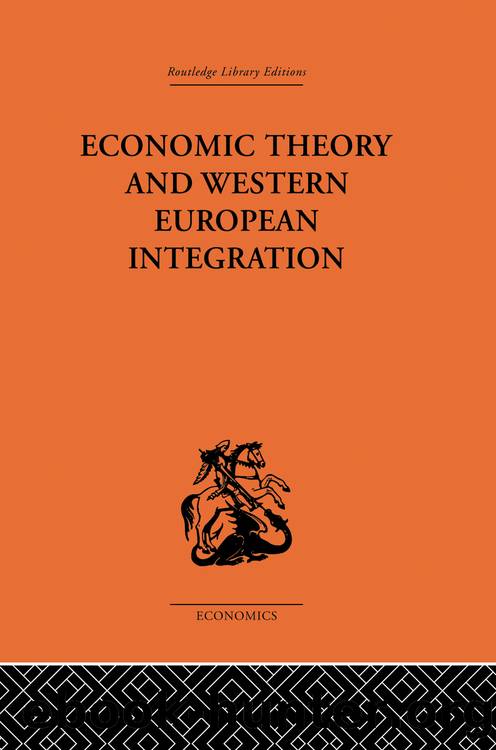Economic Theory and Western European Intergration by Scitovsky Tibor;

Author:Scitovsky, Tibor;
Language: eng
Format: epub
ISBN: 1461021
Publisher: Taylor & Francis Group
A. THE THEORY OF THE BALANCE OF PAYMENTS
In searching for the market forces that tend towards balance-of-payments equilibrium, it is natural to begin with a survey of the accepted theories. There are two of these: the classical theory and the modern or income theory of the balance of payments.
1. The Classical Theory
The classical theory is a dynamic equilibrium theory: dynamic, because it deals with a process of adjustment over time, equilibrium, because it asserts the existence of a tendency towards balance-of-payments equilibrium. Its earliest formulation is David Humeâs, who argued that a flow of specie from one country to another will lower prices in the first, raise them in the second, and that this divergent movement in the two countriesâ price levels will continue until balance-of-payments equilibrium is reestablished and specie ceases to flow. This is nowadays regarded as a crude mechanistic formulation of the classical theory; but in Humeâs day it may have been quite realistic even in this form. For one thing, prices were probably more flexible then than they are now; for another, money in Humeâs day was, if not the only, certainly the most important store of value. Hence, a significant change in the stock of money implied a significant change in the total accumulated stock of wealth; and such a change is generally believed to affect expenditures out of given incomes (the Pigou effect), and thusâwhen prices are flexibleâalso prices.
Since Humeâs time, there has been a great accumulation of wealth in the Western countries, most of it held in forms other than specie; and this implies that a given percentage change in a countryâs stock of monetary reserves now represents a much smaller percentage change in its inhabitantsâ accumulated stock of wealth and is likely therefore to have a much smaller impact on their propensity to spend. Indeed, this impact is generally held to be negligible in advanced economies; and later restatements of Humeâs theory have stressed therefore the role of monetary policy. According to these, the flow of gold does not change price levels automatically but causes the two countriesâ monetary authorities to change their policies; and it is they who, in an effort to stop the gold flow, engage in policies of contraction and expansion respectively and thus cause the price changes that re-establish balance-of-payments equilibrium. A further refinement of the theory showed that the influence of monetary policy on the balance of payments may be exerted through its effect not only on prices but also on levels of income and economic activity. Some writers have also argued that during the decades before World War I the effectiveness of monetary policy in maintaining balance-of-payments equilibrium has been due to the effect of bank rates on the international flow of speculative short-term capital no less than to their effect on price, income and activity levels.
Today, this entire body of theory is all but relegated to the history of economic doctrine, not because it ceased to be true, but because we have realized and, what
Download
This site does not store any files on its server. We only index and link to content provided by other sites. Please contact the content providers to delete copyright contents if any and email us, we'll remove relevant links or contents immediately.
The Meaning of the Library by unknow(2385)
Six Billion Shoppers by Porter Erisman(2224)
Why Nations Fail: The Origins of Power, Prosperity, and Poverty by Daron Acemoglu & James Robinson(2170)
No Time to Say Goodbye(1996)
Red Notice by Bill Browder(1924)
The Economist [T6, 22 Thg9 2017] by The Economist(1843)
Currency Trading For Dummies by Brian Dolan(1788)
Thank You for Being Late by Thomas L. Friedman(1675)
Bitcoin: The Ultimate Guide to the World of Bitcoin, Bitcoin Mining, Bitcoin Investing, Blockchain Technology, Cryptocurrency (2nd Edition) by Ikuya Takashima(1611)
Amazon FBA: Amazon FBA Blackbook: Everything You Need To Know to Start Your Amazon Business Empire (Amazon Empire, FBA Mastery) by John Fisher(1491)
Coffee: From Bean to Barista by Robert W. Thurston(1418)
The Future Is Asian by Parag Khanna(1397)
The Great Economists by Linda Yueh(1389)
Capitalism Without Capital: The Rise of the Intangible Economy by Jonathan Haskel(1337)
Pocket World in Figures 2018 by The Economist(1325)
How Money Got Free: Bitcoin and the Fight for the Future of Finance by Brian Patrick Eha(1322)
Grave New World by Stephen D. King(1314)
The Sex Business by Economist(1279)
Cultural Intelligence by David C. Thomas(1201)
